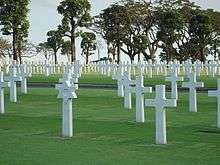Manila American Cemetery
| Manila American Cemetery and Memorial | |
|---|---|
| American Battle Monuments Commission | |
|
Manila American Cemetery headstones with memorial building behind. | |
| Used for those deceased 1941–1945 | |
| Established | 1948 |
| Location | 14°32′28″N 121°03′00″E / 14.541°N 121.050°ECoordinates: 14°32′28″N 121°03′00″E / 14.541°N 121.050°E |
| Designed by | Gardener A. Dailey |
| Total burials | 17,206 |
| Unknown burials | 3,744 |
| Burials by nation | |
| |
| Burials by war | |
| |
| Statistics source: American Battle Monuments Commission | |

The Manila American Cemetery and Memorial is located in Fort Bonifacio, Metro Manila, within the boundaries of the former Fort William McKinley. It can be reached most easily from the city via Epifano de los Santos Ave. (EDSA) to McKinley Road, then to McKinley Parkway inside the Bonifacio Global City. The Nichols Field Road is the easiest access from Manila International Airport to the cemetery.[1]
The cemetery, 152 acres (62 ha) or 615,000 square metres in area, is located on a prominent plateau, visible at a distance from the east, south and west.[1] With a total of 17,206 graves, it has the largest number of graves of any cemetery for U.S. personnel killed during World War II and holds war dead from the Philippines and other allied nations.[1] Many of the personnel whose remains are interred or represented were killed in New Guinea, or during the Battle of the Philippines (1941–42) or the Allied recapture of the islands.[1] The headstones are made of marble which are aligned in eleven plots forming a generally circular pattern, set among a wide variety of tropical trees and shrubbery.[1] The Memorial is maintained by the American Battle Monuments Commission.
The cemetery is open daily to the public from 9:00 a.m. to 5:00 p.m. except December 25 and January 1.[1]
Otherwise, this cemetery has only one Commonwealth War Dead burial in World War I.[2]
General layout
The entrance to the cemetery is at the far (east) side of the large grassed circle just beyond the military sentinel's post which is at the junction of Rizal Drive and Eighth Avenue . Immediately beyond the gate is the plaza with its circular fountain; at the right is the Visitors' Building. Stretching from the plaza to the memorial is the central mall, which is lined with mahogany trees (Swietenia macrophylla). Circular roads leading eastward and westward through the graves area join the straight roads along the edges of the mall.
The memorial
Twenty-five large mosaic maps in four rooms recall the actions of the United States Armed Forces in the Pacific, China, India and Burma.[1] Carved in the floors are the seals of the American states and its territories.[1]
Notable burials and memorials
Twenty-three Medal of Honor recipients are buried or memorialized at the Manila cemetery. Also honored are the five Sullivan Brothers, who perished when the light cruiser USS Juneau (CL-52) was sunk in June 1942. A. Peter Dewey (1916–1945), an OSS officer killed in Saigon shortly after World War II ended, is listed on the Tablets of the Missing.[3] The Camp O'Donnell Memorial is dedicated to the memory of the "Battling Bastards of Bataan".[4]
Medal of Honor recipients
- Burials
- Dale E. Christensen (1920–1944), for action in New Guinea in July 1944
- Leroy Johnson (1919–1944), for action at Leyte, Philippines
- Charles E. Mower (1924–1944), for action at Leyte, Philippines
- Robert A. Owens (1920–1943), for action at Bougainville
- Charles H. Roan (1923–1944), for action at Peleliu Island, Palau
- William H. Thomas (1923–1945), for action in the Zambales Mountains, Luzon, Philippines
- Louis J. Van Schaick (1875–1945), for action against Philippine insurgents in 1901
- Cenotaphs and memorial listings
- George F. Davis (1911–1945), for action in the invasion of Lingayen Gulf
- Samuel D. Dealey (1906–1944), for action off of Luzon
- Ernest E. Evans (1908–1944), for action in the Battle of Samar
- Elmer E. Fryar (1914–1944), for action at Leyte, Philippines
- Howard W. Gilmore (1902–1943), for action in the Southwest Pacific
- Robert M. Hanson (1920–1944), for action at Bougainville and New Britain Islands
- Alexander R. Nininger, Jr. (1918–1942), for action at Bataan
- Harl Pease, Jr. (1917–1942), for action over New Guinea
- Oscar V. Peterson (1899–1942), for action aboard the USS Neosho
- Milton E. Ricketts (1913–1942), for action aboard the USS Yorktown in the Battle of the Coral Sea
- Albert H. Rooks (1891–1942), for action commanding the USS Houston
- Norman Scott (1889–1942), for action as second in command in the Battle of Guadalcanal
- Kenneth N. Walker (1898–1943), for actions commanding the USAAF 5th Bomber Command in the South Pacific Theater
- George Watson (1915–1943), for action near New Guinea
- Raymond H. Wilkins (1917–1943), for action at Simpson Harbor, Rabaul, New Britain
- Cassin Young (1894–1942), for action commanding the USS Vestal during the attack on Pearl Harbor
Other notable people
- Hilan Ebert (1903–1942), Navy Cross for action aboard the USS Northampton in the Battle of Guadalcanal
References
- 1 2 3 4 5 6 7 8 "Manila American Cemetery and Memorial". The American Battle Monuments Commission. Retrieved 18 February 2013.
- ↑ CWGC: AMERICAN MILITARY CEMETERY, FORT BONIFACIO, MANILA
- ↑ American Battle Monuments Commission.
- ↑ Camp O'Donnell Memorial at Find a Grave
Bibliography
- Sledge, Michael (2005). Soldier Dead: How We Recover, Identify, Bury, and Honor Our Military Fallen. New York: Columbia University Press. pp. 209–10. ISBN 9780231509374. OCLC 60527603.
- Manila American Cemetery and Memorial
External links
| Wikimedia Commons has media related to Manila American Cemetery. |
- Manila American Cemetery and Memorial Official Website from the American Battle Monuments Commission including a video and several photos, some in the public domain.
- Manila American Cemetery and Memorial: Many Photographs and Information about the Cemetery and Memorial.
- Manila American Cemetery and Memorial at Find a Grave

